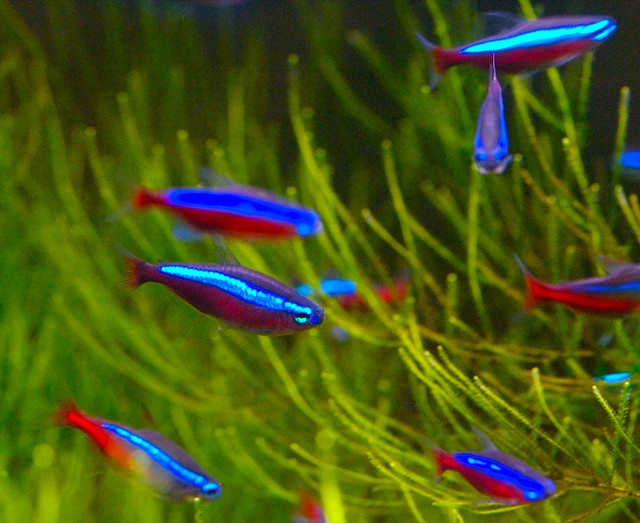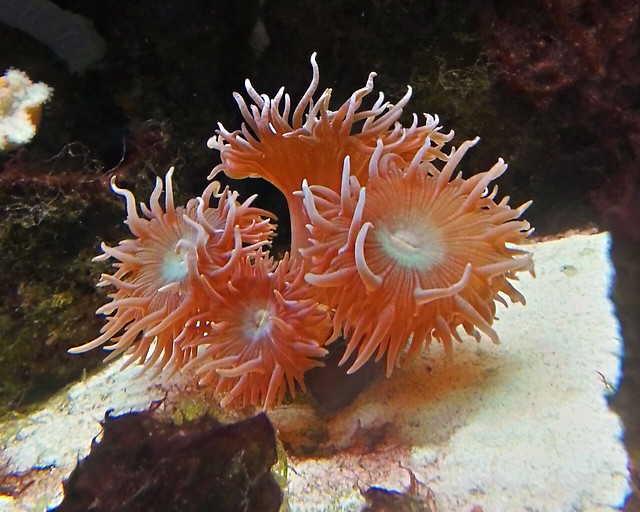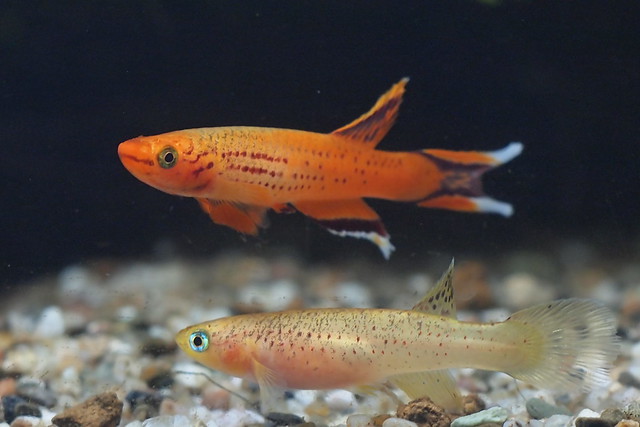 |
| Photo by Leino88 |
Ne tetras are hence popular among aquarists because they are hardy fish. They are peaceful fish and seldom nip at each other or any other fish in a community cooler. However, atomic number 10 tetras are schooling fish and these fish are happiest if they are in a schoolhouse or in a group of 5 or more. Schools or groupings make the fish experience really good. Atomic number 10s are likewise very active fish and they flit about a lot in the tank. This is a joyousness to check.
Ne tetras can dwell for rattling long periods if they are given proper care. 10 years is a potential lifespan of the shipshape Ne tetra. Neons unremarkably reside the middle or bottom levels of a storage tank and can grow up to 4 atomic number 96s. in length. The ph scale of the water should ideally be between 5.5 and 7.8. Their favorite water temperature is within the reach of 68 levels F to 75 levels F. The fish are generally spindle-shaped. The belly area is a bit lashed out especially among the female persons. The nose is blunt. A wide violent band runs down the body of the Ne tetra and extends up o the Caudal fin. A grim band that runs from the upper portion of the center premises this. The side above this is olive green while the lower side is silvery. The anal fin is mostly transparent. This prominent collage of coloring materials, peculiarly the counterpointing reddened and green, stimulates the Ne tetra one of the most popular and colored fishes in the freshwater aquarium.
Dark substratum and curbed lighting is the most suited for neon tetras. Putting in sets of floras is besides very good for the timid and active atomic number 10s. Some driftwood is too advisable. The tetras should not be kept with bigger fish, or they will end up becoming tiffin. Since neon tetras are therefore democratic, they have found out to adapt themselves to a wide range of habitats. But, ferocious breeding of the tetras to issue adequate fish for the burgeoning demand for atomic number 10 tetras has led to the loss of their native robustness. New fish are very delicate and chances of losing fish just after they are introduced into a cooler are very high. Withal, erstwhile the Ne tetras have shown themselves, they get along quite an intimately without too much difficultness.
Neon tetra s are ball scatterers. They are a bit unmanageable to breed in enslavement. This is by and large due to an unsuitable body of water experimental conditions. Eggs of the Ne tetras appear to be light sensitive, hence Ne tetras postulate to be placed in a dark berth, as they get ready to spawn. A 2 3 inch layer of rock and some fine rough textured live floras are the best medium for spawning. The water temperature should not be above 75 points F. A hat should be kept on the tank at such a time, as the fish be given to bound very high during this period. While breeding the nes, it is necessary to look for the healthiest breeders. Merely young fish should be used for breeding determinations.
s are ball scatterers. They are a bit unmanageable to breed in enslavement. This is by and large due to an unsuitable body of water experimental conditions. Eggs of the Ne tetras appear to be light sensitive, hence Ne tetras postulate to be placed in a dark berth, as they get ready to spawn. A 2 3 inch layer of rock and some fine rough textured live floras are the best medium for spawning. The water temperature should not be above 75 points F. A hat should be kept on the tank at such a time, as the fish be given to bound very high during this period. While breeding the nes, it is necessary to look for the healthiest breeders. Merely young fish should be used for breeding determinations.
They should be coursed some live solid foods especially 2 3 days before breeding. These breeders have to be gone away in a spawning medium for about a day. The testicles are usually liberated ahead of time in the morning. The ballocks are well-nigh transparent and scantily stick to the surface of plants. The eggs will incubate in about 22-30 minutes. The small fry is very hard to spot at once. But, as soon as they get free to swim in 3-4 days, they will be seen very clearly, though they are yet very small. The stockbreeders should be removed as soon as the ballocks are spotted. As soon as the tike is loose swimming they should be preyed with infusoria. Ne tetras that breed in incarceration are not very fertile. A good spawn would consist of about 40-55 tyke only.
They should be coursed some live solid foods especially 2 3 days before breeding. These breeders have to be gone away in a spawning medium for about a day. The testicles are usually liberated ahead of time in the morning. The ballocks are well-nigh transparent and scantily stick to the surface of plants. The eggs will incubate in about 22-30 minutes. The small fry is very hard to spot at once. But, as soon as they get free to swim in 3-4 days, they will be seen very clearly, though they are yet very small. The stockbreeders should be removed as soon as the ballocks are spotted. As soon as the tike is loose swimming they should be preyed with infusoria. Ne tetras that breed in incarceration are not very fertile. A good spawn would consist of about 40-55 tyke only.
Author: Ad Brown - Articles Source: GoArticles
|






